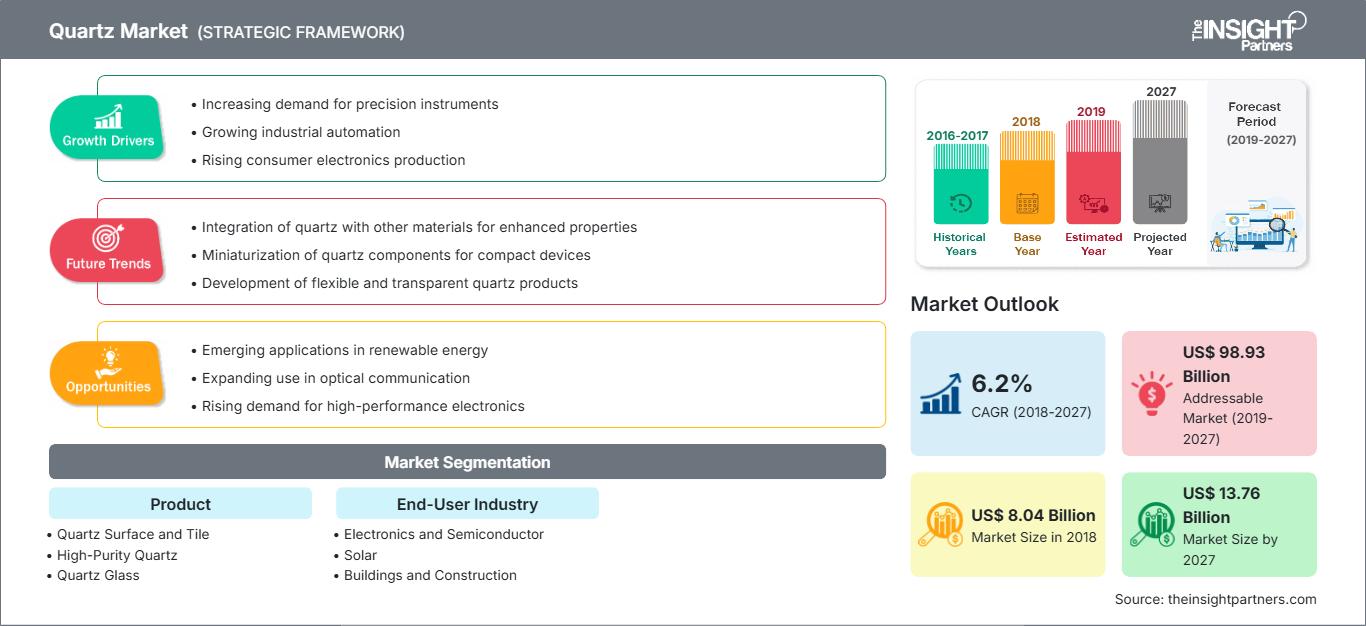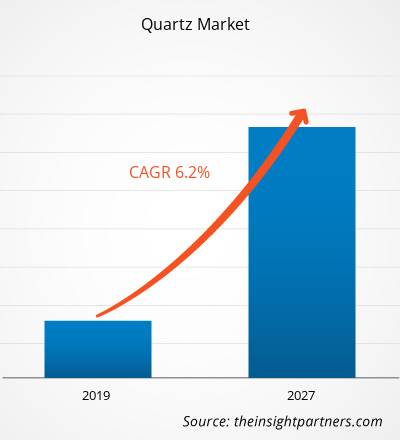Der Quarzmarkt belief sich 2018 auf 8.037,0 Mio. US-Dollar und wird im Prognosezeitraum 2019–2027 voraussichtlich mit einer durchschnittlichen jährlichen Wachstumsrate von 6,2 % wachsen und bis 2027 13.762,6 Mio. US-Dollar erreichen.
Quarz ist eine mineralische Form von SiO2, die bei niedrigen Temperaturen und Drücken stabil ist. Man findet ihn in magmatischen, sedimentären, metamorphen und hydrothermalen Mineralumgebungen, hauptsächlich in kontinentalen Regionen. Er ist äußerst widerstandsfähig gegen mechanische und chemische Verwitterung und aufgrund seiner hohen Haltbarkeit das vorherrschende Mineral auf Berggipfeln und der Hauptbestandteil von Fluss-, Strand- und Wüstensand. Der asiatisch-pazifische Raum hatte den größten Marktanteil am globalen Quarzmarkt. Die Region ist geprägt von der Präsenz zahlreicher Quarzhersteller wie Caesarstone, Hanwha L&C und Dupont Cosentino Group, die das Wachstum des Quarzmarktes vorantreiben. Die schnelle Einführung innovativer und fortschrittlicher Technologien durch diese Akteure zur Verbesserung der Betriebseffizienz dürfte den Quarzmarkt in der Region Asien-Pazifik im Prognosezeitraum ankurbeln. Die zunehmende industrielle Entwicklung in Verbindung mit steigenden staatlichen Investitionen in die Automobil-, Elektro- und Elektronikinfrastruktur dürfte den Quarzmarkt in den kommenden Jahren beflügeln. Auch die steigenden Investitionen in Forschung und Entwicklung für die Quarzproduktion dürften das Wachstum des Quarzmarktes im asiatisch-pazifischen Raum ankurbeln. Indien, China und Japan sind die größten Länder und tragen zum gesamten Quarzmarkt im asiatisch-pazifischen Raum bei.
Passen Sie diesen Bericht Ihren Anforderungen an
Sie erhalten kostenlos Anpassungen an jedem Bericht, einschließlich Teilen dieses Berichts oder einer Analyse auf Länderebene, eines Excel-Datenpakets sowie tolle Angebote und Rabatte für Start-ups und Universitäten.
Quarzmarkt: Strategische Einblicke

- Holen Sie sich die wichtigsten Markttrends aus diesem Bericht.Dieses KOSTENLOSE Beispiel umfasst Datenanalysen, die von Markttrends bis hin zu Schätzungen und Prognosen reichen.
Markteinblicke: Hohe Verfügbarkeit und breites Anwendungsspektrum von Quarz treiben den Quarzmarkt an
Sie erhalten kostenlos Anpassungen an jedem Bericht, einschließlich Teilen dieses Berichts oder einer Analyse auf Länderebene, eines Excel-Datenpakets sowie tolle Angebote und Rabatte für Start-ups und Universitäten.
Quarzmarkt: Strategische Einblicke

- Holen Sie sich die wichtigsten Markttrends aus diesem Bericht.Dieses KOSTENLOSE Beispiel umfasst Datenanalysen, die von Markttrends bis hin zu Schätzungen und Prognosen reichen.
Quarz findet Verwendung in zahlreichen Branchen wie der Elektronik- und Halbleiterindustrie, der Solarindustrie, der Bauindustrie, der Medizintechnik sowie der Optik und Telekommunikation. Quarz kommt in der Natur in unterschiedlichen Varianten, Formen, Transparenzen und Farben vor, was seinen Wert und seine Anwendungsmöglichkeiten weiter steigert. Verschiedene Arten von farbigem Quarz gelten als Halbedelsteine und werden häufig für Schmuck und Steinmetzarbeiten verwendet. Amethyst, Ametrin, Citrin und Opal sind Edel- oder Halbedelsteine, die aufgrund ihrer Farbe und Haltbarkeit häufig für Schmuck verwendet werden. Zu Quarzsand gemahlen, kann dieser bei der Herstellung von Fiberglas und als Schleifmittel beim Sandstrahlen und Steinschneiden verwendet werden. Reiner Quarzsand wird häufig in Wasseraufbereitungssystemen eingesetzt. Kleine Chips aus Quarz werden in Armbanduhren, Fernsehern, Uhren, Computern und Stereoanlagen verwendet, da Quarz unter Druck elektrische Spannung erzeugen kann, mit der sich die Frequenz elektrischer Impulse steuern lässt.
Die steigende Nachfrage nach synthetischem Quarz dürfte den Quarzmarkt weltweit ankurbeln.
Synthetischer Quarz bietet verschiedene vorteilhafte Eigenschaften wie Säure-, Korrosions-, Temperatur-, Stoß-, Verschleiß-, Druck-, Biege- und Infiltrationsbeständigkeit. Daher wird er häufig in der Elektronik- und Halbleiterindustrie eingesetzt. Synthetischer Quarz wird vor allem in optischen Komponenten verwendet, die in Wellenlängenlasern von Mikrolithografie-Projektionssystemen eingesetzt werden. Die optischen Komponenten aus synthetischem Quarz werden zur Übertragung hochenergetischer ultravioletter Laserstrahlung zur Herstellung hochintegrierter Schaltkreise verwendet. Synthetische Quarzkomponenten sind sehr laserbeständig und daher für Hochleistungs- oder Kurzwellenlaser geeignet. Synthetischer Quarz wird auch zur Herstellung von Tiegeln verwendet, in denen Einkristall-Silizium gezogen wird, das zur Herstellung von Halbleiterbauelementen und Solarzellen verwendet wird. Hochreiner Quarz wird außerdem für Einkristall-Ingots aus Siliziummetall in der Solarindustrie verwendet. Derzeit werden die meisten Quarzkristalle, die in optischen Instrumenten und elektronischen Komponenten verwendet werden, in Laboren hergestellt und nicht in Minen abgebaut. Die leichte Verfügbarkeit von synthetischem Quarz und seine Anwendung in verschiedenen Branchen wie der Elektronik- und Elektroindustrie, der Automobilindustrie und dem Bauwesen zählen daher zu den Faktoren, die die Nachfrage nach synthetischem Quarz ankurbeln und den Quarzmarkt weltweit beeinflussen.
Produkteinblicke
Auf Produktbasis wurde der globale Quarzmarkt in Quarzoberflächen und -fliesen, hochreinen Quarz, Quarzglas, Quarzkristall, Quarzsand und andere segmentiert. Im Produktsegment führte der Markt für Quarzoberflächen und -fliesen zum globalen Quarzmarkt. Darüber hinaus wird erwartet, dass das Segment für hochreinen Quarz im Prognosezeitraum die schnellste CAGR verzeichnet. Hochreiner Quarz (HPQ) weist eine vernachlässigbare Menge an Verunreinigungen auf und wird mit über 99 % Siliziumdioxid hergestellt. HPQ wird in Branchen wie der Halbleiter-, Solar-, Glasfaser- und Beleuchtungsindustrie verwendet. Hochreiner Quarzglas wird aus hochreinem Quarz hergestellt und bietet ein breites Spektrum an optischen, mechanischen und thermischen Eigenschaften, die für die Herstellung verschiedener Hightech-Produkte unverzichtbar sind. Die wachsende Nachfrage nach hochreinem Quarz aus der Halbleiterindustrie ist der Hauptfaktor, der die weltweite Nachfrage antreibt. In der Halbleiterindustrie wird HPQ beispielsweise zur Herstellung von Röhren, Tiegeln und Stäben verwendet.
Einblicke in die Endverbraucherbranche
Der globale Quarzmarkt der Endverbraucherbranche wurde in die Branchen Elektronik und Halbleiter, Solar, Gebäude und Bauwesen, Medizin, Optik und Telekommunikation und Sonstige unterteilt. Das Segment Elektronik und Halbleiter hatte den größten Anteil am globalen Quarzmarkt. Quarz wird häufig in elektronischen Geräten wie Resonatoren verwendet, um eine stabile Leistung zu gewährleisten. Natürlich vorkommender reiner Quarz wird in der Halbleiterindustrie zum Züchten von Silizium-Wafern verwendet. Reiner Quarzsand wird zur Herstellung von Siliziummetall-Halbleitern für Transistoren, bei der Entwicklung von integrierten Schaltkreisen, in der Mikroelektronik und für Siliziumchips verwendet. Quarz wird auch als piezoelektrische Zelle verwendet, die bei Belastung Strom erzeugt und sogar einen umgekehrten Effekt hat.
Fusionen und Übernahmen erwiesen sich als die am häufigsten angewandten Strategien auf dem globalen Quarzmarkt. Einige der jüngsten Entwicklungen auf dem globalen Quarzmarkt sind unten aufgeführt:
2019: Saint Gobain SA führte Forschung und Entwicklung für neue Anwendungsmöglichkeiten durch. 2017: Quality Quartz Engineering wurde ausgewählt, um die Konstruktionsentwicklung für einen tragenden Quarzstab durchzuführen, der für die Energieversorgung des größten Fusionsreaktors der Welt von entscheidender Bedeutung ist.
Quarzmarkt
Die Analysten von The Insight Partners haben die regionalen Trends und Faktoren, die den Quarzmarkt im Prognosezeitraum beeinflussen, ausführlich erläutert. In diesem Abschnitt werden auch die Marktsegmente und die geografische Lage in Nordamerika, Europa, dem asiatisch-pazifischen Raum, dem Nahen Osten und Afrika sowie Süd- und Mittelamerika erörtert.Umfang des Quarzmarktberichts
| Berichtsattribut | Einzelheiten |
|---|---|
| Marktgröße in 2018 | US$ 8.04 Billion |
| Marktgröße nach 2027 | US$ 13.76 Billion |
| Globale CAGR (2018 - 2027) | 6.2% |
| Historische Daten | 2016-2017 |
| Prognosezeitraum | 2019-2027 |
| Abgedeckte Segmente |
By Produkt
|
| Abgedeckte Regionen und Länder | Nordamerika
|
| Marktführer und wichtige Unternehmensprofile |
|
Dichte der Akteure auf dem Quarzmarkt: Ihre Auswirkungen auf die Geschäftsdynamik verstehen
Der Quarzmarkt wächst rasant, angetrieben durch die steigende Endverbrauchernachfrage aufgrund von Faktoren wie sich entwickelnden Verbraucherpräferenzen, technologischem Fortschritt und einem stärkeren Bewusstsein für die Produktvorteile. Mit steigender Nachfrage erweitern Unternehmen ihr Angebot, entwickeln Innovationen, um den Verbraucherbedürfnissen gerecht zu werden, und nutzen neue Trends, was das Marktwachstum weiter ankurbelt.

- Holen Sie sich die Quarzmarkt Übersicht der wichtigsten Akteure
Globaler Quarzmarkt – Nach Produkt
- Quarzoberfläche und -fliese
- Hochreiner Quarz
- Quarzglas
- Quarzkristall
- Quarzsand
- Sonstige
Globaler Quarzmarkt – Nach Endverbraucherbranche
- Elektronik und Halbleiter
- Solar
- Gebäude und Bau
- Medizin
- Optik und Telekommunikation
- Sonstige
Globaler Quarzmarkt – Nach Geografie
Nord Amerika
- USA
- Kanada
- Mexiko
Europa
- Deutschland
- Frankreich
- Italien
- Großbritannien
- Russland
- Übriges Europa
Asien Pazifik
- Australien
- China
- Indien
- Japan
- Südkorea
- Übriger Asien-Pazifik
Naher Osten und Afrika (MEA)
- Südafrika
- Saudi-Arabien
- VAE
- Rest von MEA
Süd Amerika
- Brasilien
- Argentinien
- Rest von Südamerika (SAM)
Firmenprofile
- Caesarstone Ltd
- Thermo Fisher Scientific Inc.
- Sibelco
- EI DU Pont De Nemours and Company
- Saint Gobain SA
- Creswick Quartz
- Quartz Corporation
- Momentive Performance Materials Inc.
- Baba Quartz
- Quality Quartz Engineering
- Historische Analyse (2 Jahre), Basisjahr, Prognose (7 Jahre) mit CAGR
- PEST- und SWOT-Analyse
- Marktgröße Wert/Volumen – Global, Regional, Land
- Branchen- und Wettbewerbslandschaft
- Excel-Datensatz
Aktuelle Berichte
Erfahrungsberichte
Grund zum Kauf
- Fundierte Entscheidungsfindung
- Marktdynamik verstehen
- Wettbewerbsanalyse
- Kundeneinblicke
- Marktprognosen
- Risikominimierung
- Strategische Planung
- Investitionsbegründung
- Identifizierung neuer Märkte
- Verbesserung von Marketingstrategien
- Steigerung der Betriebseffizienz
- Anpassung an regulatorische Trends






















 Kostenlose Probe anfordern für - Quarzmarkt
Kostenlose Probe anfordern für - Quarzmarkt